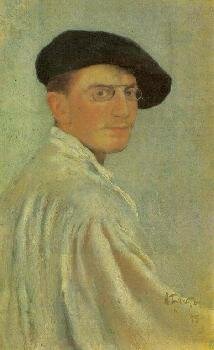 Lev Samuilovich Bakst27.01.1866 Grodno - 27.12.1924 Paris Art history: SymbolismCanvases of Lev Samuilovich Bakst [11 canvases]
Biography of Lev Samuilovich BakstLeon was born Lev Rosenberg in Grodno (currently Belarus) in a middle class Jewish family. After graduating from gymnasium, he studied in St. Petersburg Academy of Arts as a noncredit student, working part-time as a book illustrator. On his first exhibition (1889) he took the name of Bakst based on his maternal grandmother's family name Baxter. In the beginning of 90-ies he exponated his works with Society of watercolourists. In 1893 - 1897 he lived in Paris, visiting Saint Petersburg often. Since mid-1890ies he became a member of the circle of writers and artists formed by Sergei Diaghilev and Alexandre Benois that later became Mir Iskusstva art movement. In 1899, he co-founded with Sergei Diaghilev the influential periodical World of Art. His graphics for the World of Art magazine brought him fame. He continued easel painting as well producing portraits of Malyavin (1899), Vasily Rozanov (1901), Andrei Bely (1905), Zinaida Gippius (1906). He also worked as an art teacher for children of Grand Duke Vladimir Alexandrovich. In 1902 he took the order from tsar Nicholas II to paint Meeting of Russian sailors in Paris. In 1898 he showed his works on Dyagilev-organized First exhibition of Russian and Finnish Artists; in World of Art exhibitions, as well as Secession in Munich, exhibitions of Union of Russian Artists, etc. During Russian Revolution of 1905 Bakst works for magazines Zhupel, Adskaja Pochta, Satyricon, then he worked for art magazine Apollon. Since the end of 1900es, Bakst works mostly as a stage-desigher. Bakst designed settings for Greek tragedies, and in 1908 made a name as a scene-painter for Diaghilev with the Ballets Russes ((Cleopatra 1909, Shakherezada 1910, Carnaval 1910, Narcissus 1911, Daphnis et Chlo? 1912). All that time he lived in Europe because as a Jew he did not have the right to live permanently outside the Pale of Settlement. During his visits to Saint Petersburg he taught in Zvantseva's school. One of his students was Marc Chagall (1908-1910). In 1910 they broke. Bakst advised Chagall not to go to Paris as according to Bakst it would be harmful for Chagal's art and financially would probably make in die of starvation. Chagall moved there anyway, did not die and actually found his style. In 1914 he was elected a member of Imperial Academy of Arts. In 1918 he broke his relation with Dyagilev and Ballets Russes. He died in 1924 in Paris out of lung problems.
You can find canvases of this artist in these museums:
|
Для красивого отображения Облака Quick Search artists |
|||||||||||||||